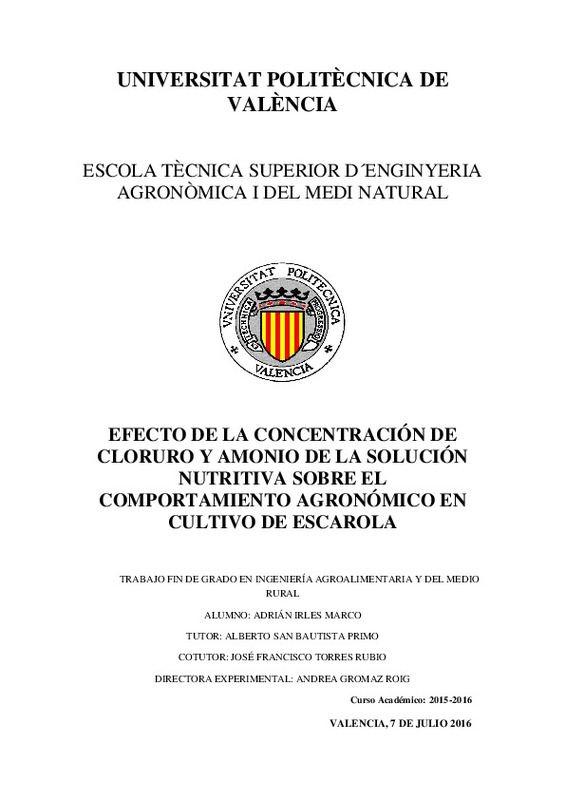|
Resumen:
|
[ES] La acumulación de nitratos en plantas aprovechables por sus hojas, como es el caso de la escarola, Cichorium endivia L, puede tener efectos perjudiciales en la salud humana. Esta acumulación está influenciada, entre ...[+]
[ES] La acumulación de nitratos en plantas aprovechables por sus hojas, como es el caso de la escarola, Cichorium endivia L, puede tener efectos perjudiciales en la salud humana. Esta acumulación está influenciada, entre otros factores, por el aporte de nitrógeno que se realiza con el abonado, así como la forma en la que se aplica (fundamentalmente nítrico o amoniacal). En las células, los nitratos tienen una función osmótica, ayudando a mantener su turgencia, por lo que el aporte en la solución nutritiva de otros iones con una función similar, como es el caso de los cloruros, puede reducir su acumulación. Los nitratos, antes de integrarse al proceso de síntesis de aminoácidos, se acumulan en las vacuolas donde se reducen a amonio. Aplicando el nitrógeno en forma amoniacal, este pasa a ser empleado directamente en la síntesis aminoácidos, lo que puede reducir la acumulación de nitratos en hojas. Por estas razones, se estableció como objetivo de este experimento estudiar la influencia en la concentración de nitratos en hojas, así como en el rendimiento del cultivo, de seis soluciones nutritivas. Todas las soluciones presentarán el mismo contenido de nitrógeno. Las plantas se agruparon en tres bloques, inicialmente a cada uno de los bloques se le aplicará una solución nutritiva con distinto porcentaje de cloro respecto del nitrógeno total (5% aplicado en forma amónica), (0:0% Cl-; 20:20% Cl-; 40:40% Cl-); a partir del día 21 la mitad de las plantas de cada bloque, se regará con las tres soluciones restantes con los mismos porcentajes de Cl- anteriormente citados, pero incrementando la proporción de nitrógeno aplicado en forma amónica hasta un 20%. Durante todo su ciclo, 42 ddt (días después del trasplante), se determinará la evolución de distintos parámetros fisiológicos y de calidad. Además, se pretende esclarecer si a partir de las medidas realizadas con el SPAD y el colorímetro se podrá estimar de una forma indirecta la acumulación de nitratos en escarola. Para todo ello, se utilizará, el cultivar de hoja ancha Cuartana . Semanalmente, desde el día del trasplante hasta los 42 ddt se analizará la evolución del área foliar y la tasa de crecimiento; por otro lado, periódicamente (0, 14, 28, 42 ddt) se observará la evolución de distintos parámetros fisiológicos y de calidad (contenido de clorofilas (SPAD), nitratos (reflectometría), nitrógeno (Kjeldahl), fósforo (colorimetría) y color de las hojas (escala CIEL*a*b*)). Adicionalmente, al final del cultivo, se valorará el porcentaje de plantas comerciales, su peso medio y la incidencia de distintas fisiopatías ( tipburn y subida a flor prematura).
[-]
[EN] Nitrate accumulation in plants which are grown for the consumption of their leaves, like
the endive (Cichorium endivia L.), can have damaging effects on the human health. This
accumulation is influenced, among other ...[+]
[EN] Nitrate accumulation in plants which are grown for the consumption of their leaves, like
the endive (Cichorium endivia L.), can have damaging effects on the human health. This
accumulation is influenced, among other factors, by the nitrogen fertilization, and by the
chemical form of nitrogen that is used (ammonium or nitric form). In cells, nitrates have
an osmotic function, helping to maintain turgor, so the supply in the nutrient solution of
other ions which function is similar, like chloride, can reduce its accumulation. Nitrates,
before getting into the aminoacids synthesis process, are accumultaed in the vacuoles
where are reduced to ammonium. Using nitrogen in ammonium form, wich is directly in
the aminoacids synthesis, can reduce the nitrate accumulation on leaves. For these
reasons, it was set as an objective of this experiment to study the influence of six nutrient
solutions on the nitrate concentration on leaves, as well as the yield. All the nutrient
solutions have the same level of nitrogen. The plants were put in three blocks. At first it
was applied to each block a nutrition solution with different chloride percentage regarding
the total nitrogen (5% applied in ammonium form) (Cl0:0% Cl-
; Cl20:20% Cl-
; Cl40:40%
Cl-
). 21 days after the trasplant half of the plants of each block were irrigated with the
three solutions with the same Cl- percentage already mentioned, but increasing the
nitroten proportion applied in the ammonium form until the 20 %. Along all the cycle (42
days after the transplant), were determined the evolution of different physiological and
quality parameters. Furthermore, there were determined the correlations between the
nitrate content and the SPAD and colorimeter values. All the results were taken from a
wide leaf variety’Cuartana’. Every week, since the transplant until the 42 days after it
was analyzed the grown rate. Moreover, the evolution of different physiological and
quality parameters were observed periodically (chlorophyll content, nitrates, nitrogen and
leaf color). Besides, the commercial plants percentage, their weight and the incidence of
“tipburn” were assessed.
[-]
|







